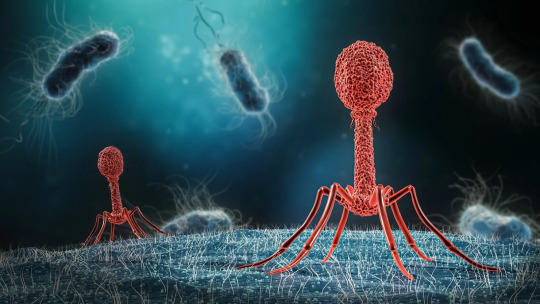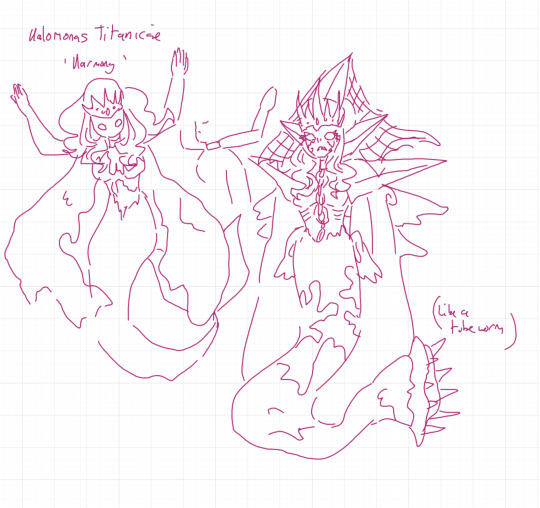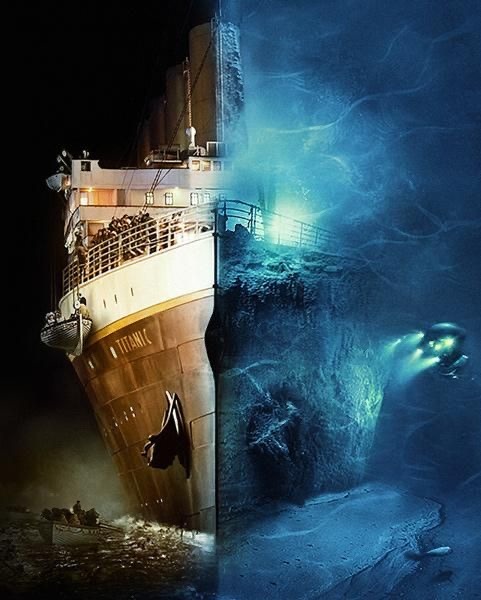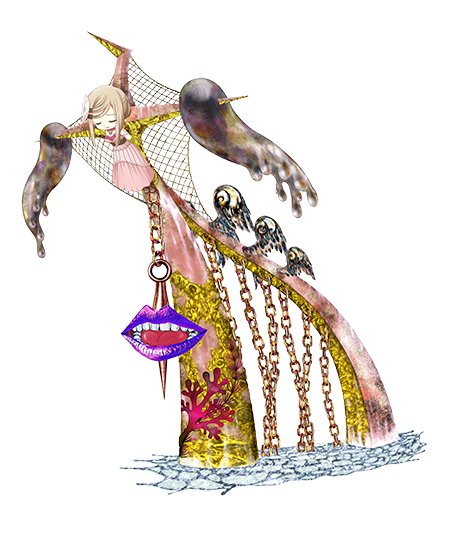#Halomonas Titanicae
Text
ROUND 1, Part 4




#Round 1#Magia Record#Cuauhtitlan#Marguerite#Halomonas Titanicae#Vlastenske#Rabi Himuro#Lavi Himuro#Asahi Miura#Alexandra Kurusu#Urara Yume
25 notes
·
View notes
Text
New Deep Ocean Virus Discovered

Life on Earth can be found even in the harshest of environments. But wherever there is life, you can find regulators of that life- and by that, I mean viruses. A group of researchers at the Ocean University of China have isolated a new virus from sediment collected from the Mariana Trench, some 8,900 meters below sea level. This is the deepest discovered virus ever.
The virus in question is a bacteriophage- one that infects and replicates inside bacteria. Bacteriophages are thought to be the most abundant life forms on the planet (that is, if you even consider them to be alive. But that’s for a whole other post). This bacteriophage infects bacteria in the phylum Halomonas, which can be found in deep sea sediments or in hydrothermal vents (Fun fact: one member of this phylum, Halomonas titanicae, was isolated from the ruins of the titanic, and helps to decompose materials such as shipwrecks on the seafloor).

When the researchers analyzed this new bacteriophage, they realized that it is part of an entirely unknown viral family that has been lurking in the depths of the ocean. Now, they will investigate the molecular machinery that defines interactions between deep sea viruses and their hosts, as well as continuing to look for new viruses in the most extreme of environments.
#science#stem#stemblr#science side of tumblr#biology#medicine#virology#marine virology#oceans#mariana trench#marine biology
345 notes
·
View notes
Text
I still wish that there was a larger amount of subjectively "recent" Titanic footage to look through. I know it's really expensive and I know Oceangate Expeditions is trying to keep documenting it but like. I'm genuinely so fucking heartbroken knowing the Titanic will probably erode completely within my lifetime. Seeing the total collapse of the Captain's Cabin felt like a sledgehammer to the chest. I totally love projects dedicated to what the Titanic was like in her prime, but none of that compares to the absolute beauty of her current rusticles and bamboo coral and sea life and Halomonas Titanicae, life where there should be none. I just can't stand the thought of it being gone before we can- if nothing else- properly document her final resting place before we lose our chance at seeing her ever again
#I'm sorry I'm really fucking fixated on this boat right now it's. really really important to me#rms titanic#the rms titanic#titanic#the titanic#royal mail ship titanic
57 notes
·
View notes
Note
kicked out of the boat museum for trying to eat all the sterns
Anon is a Halomonas titanicae
0 notes
Text
A bacteria was actually named after the Titanic. It's name is Halomonas Titanicae. You can actually see the bacteria everywhere on the wreck of the Titanic as it clumps together into these icicle-looking structures nicknamed rusticles. This bacteria is also what is responsible for the wrecks extremely fast deterioration as it eats steel.

1 note
·
View note
Text
halomonas titanicae will be like “is anyone going to eat this shipwreck?” and then not wait for an answer
#this meme isnt popular at all anymore#but#halomonas titanicae#ok to rb#ok to interact#jokes#shipwrecks#titanic#history#biology#microbiology#.txt
28 notes
·
View notes
Text
Me randomly at 11 pm knowing I have submechanophobia and get really freaked out when I see things underwater: I’m gonna look up pictures of the titanic
#i fuckin hate things underwater#if i see so much as a tree in a lake#i will not go in that lake#it makes me physically uncomfortable#and i hate it#but im reading a titanic au#and it was like#Halomonas titanicae#and i was like whats that#and its the bacteria eating away at the#titanic#and it may completely deteriorate it by 2030#and its like ????? bitch ???? the titanic will legit always be in the ocean#looming#making me never want to go back in the atlantic#i fuckin hate the titanic#but i also love it ya know#love hate relationship with a gross ass ship that sits at the bottom of the ocean and in my nightmares#i just saw a picture of the stern#and oh my FUCKING GOD#that shit MESSED#ME#UP#!!!!#anyway#welcome to the shitshow#Titanic
10 notes
·
View notes
Photo



Magical Witch doppels for Vayu, Carmela and Halomonas Titanicae
#madoka magica#madoka magica witch#puella magi madoka magica#pmmm#witch#magical witch au#my art#doppel#magia record
7 notes
·
View notes
Text

Fact 10: the RMS Titanic is home to its own rust eating bacteria, Halomonas titanicae, which will leave it nothing more than a rust stain within the next few decades.
#rms titanic#titanic#titanic facts#leonardo dicaprio#jack x rose#jack dawson#rose dawson#captain smith#iceberg#shipwreck#steamship#steamboat#boat#ship#sinking#north atlantic ocean#atlantic ocean#accident death#lifeboat#billy zane#ocean liner#1910s#1990s#movies#edwardian#victorian#history#historical#travel#just facts
52 notes
·
View notes
Text
Galop Infernal
Prompt: You are on the titanic as it is sinking. What do you do?
I am one of the musicians.
“Well gentlemen,” I turn to the other time travelers sentenced behind me, “It has been an honor.”
“We’re sinking!” a man with an irish accent screams from somewhere within the vast crowd. “Save yourselves!”
Nods of agreement and murmurs of truth follow my words.
“Someone help us!” a woman shrieks. “Help!”
I raise my trombone.
A rattling cry of, “It’s cold!”
The others raise their instruments.
With calm words we dissuade the pianist from raising his own, though we all know he can.
“Shall we begin?” the violinist asks me. I ponder a moment and give a slow nod in response. Someone passes their child to another passenger. “What song shall it be, miss?”
“The is only one song that truly fits this occasion,” I solemnly regard. I wave to the cellist and violinist, indicating they take position. “Now, allow us to begin… the absolute masterpiece… Jacques Offenbach's… Galop Infernal.”
“Jolly good!” the cellist exclaims, and starts playing. “Triangle!”
People are screaming and running around us as our good triangle man hits his small instrument with all his might.
The trumpeter joins in, hitting the upbeat tune.
Someone leaps off the boat.
The trianglist, tired from bashing his instrument, sits atop the piano.
The lifeboats are being filled by women, children, the elderly, and cowards.
I lift my trombone, blowing to initiate the dance of the Can can.
To our amusement, the people before us seem to be panicking in time with the music.
It is almost a petrified rhythm of shouts and cries.
Our pianist bashes his keys with closed eyes and a pleasant grin.
What else can we do?
Our tone drops as the lifeboats are lowered into the water.
The ship tilts significantly, we all are facing out to the water, and with a rending crash, the cruiser snaps in half, in time with our beats.
The water is icy, but not as much as our hearts as we smile and play away.
With a final blow, I signal the final descent -- after all, this was capital punishment for time travelers, to perish in the manner they had caused.
We, the musicians, had caused the sinking of the colossal ship many years ago in the future.
And now, we sank to its depths.
Or we would have, had I not been prepared us an escape, a backup time machine hidden within the curve of my trombone.
There are no instruments in the wreckage of the titanic.
There is, however, a bacteria only found in that area, Halomonas titanicae, an odd little evolution of a metal eating creature.
One my time had genetically modified to cut down on the mass amounts of useless iron.
It may have clung to my trombone and thus escaped into this time period’s world.
Whoops.
#control art#control writes#queue pasa?#short#one shot#first person#titanic#sinking of the titanic#musicians#writeblr#fiction#humor and abstraction
4 notes
·
View notes
Text
ROUND 2, Part 9


10 notes
·
View notes
Text
Can you think about the fucking. Titanic with me for a second

Also this line but it's about Halomonas Titanicae specifically. Something about being a symbol of so much death that it comes back around to blooming new life, something about being slowly consumed from being so painstakingly loved

I am loved, I am loved
#the rms titanic#rms titanic#the titanic#royal mail ship titanic#titanic#me and my husband#mitski me and my husband#me and my husband mitski#mitski
33 notes
·
View notes
Photo

👉1001 Titanic facts 🔥Now, on the eve of the 100th anniversary of her demise, Titanic faces a much smaller but equally destructive foe: a newly identified rust-eating bacterium called Halomonas titanicae that threatens to devour its historic remains within 15 to 20 years. A team of Canadian and Spanish researchers isolated this never-before-seen species from “rusticles”—icicle-like rust formations—collected from the famous ship’s wreck, which lies 400 miles off the coast of Newfoundland and was discovered in 1985. Their findings appear in the December 2010 issue of the International Journal of Systematic and Evolutionary Microbiology. #titanic #titanic_fans_official #belfast #rmstitanicshop 💝🔥👉Buy Titanic souvenirs, toys, clothes - Reference under BIO 👉 @rmstitanicshop https://www.instagram.com/p/B8ZyE86n8rY/?igshid=1jmh596hw6daq
0 notes
Text
Degradación de los restosEditar
Después de Ballard, los restos del Titanic han sido sistemáticamente saqueados, extrayéndose cientos de artefactos, tales como porcelanas, botellas, maletas, etc. El estado general de los restos del Titanic ha preocupado últimamente a la comunidad científica, pues se ha verificado un aumento de la velocidad de corrosión pese a la escasa proporción de oxígeno en las frías aguas. Esto es debido a las fuertes corrientes imperantes, como la de Loreley que recorre todo el fondo marino del sector.
En 2010, un equipo de investigadores descubrió la bacteria Halomonas titanicae en los restos, y se sospecha que esta bacteria sea la responsable de acelerar el deterioro de la estructura.En 2012, y con el centenario del naufragio, el Titanic entró en la declaratoria de la UNESCO que protege los naufragios, estando ya el naufragio con su área de escombros protegidos. Aunado a esto se tiene por vez primera un mapa detallado del área de escombros cartografiando la extensión total del naufragio.
Desde el redescubrimiento de la tumba marina del Titanic en 1985, el pecio ha sido visitado intrusivamente, bien sea por motivos de investigación, saqueos de objetos personales, o simplemente por codicia y publicidad. Las visitas a los restos han sido tan relativamente frecuentes que, hasta hace poco, ha sido difícil evaluar los perjuicios adicionales causados por las exploraciones submarinas con respecto a la degradación natural del buque. El descubridor del pecio, el doctor Robert Ballard, culpó en 2004 duramente del deterioro progresivo del navío a la curiosidad humana. Sin embargo, parece ser que aún no existe consenso general entre los científicos y expertos en la citada acusación.
0 notes
Photo

💜Everybody knows that dad caps are no longer just for dads, so get an embroidered cotton twill cap for yourself! This one's really special thanks to the intricate embroidery detail and the washed out vintage feel. 👉1001 Titanic facts 💝🔥👉Buy Titanic souvenirs, toys, clothes - Reference under BIO 👉 @rmstitanicshop 🔥Now, on the eve of the 100th anniversary of her demise, Titanic faces a much smaller but equally destructive foe: a newly identified rust-eating bacterium called Halomonas titanicae that threatens to devour its historic remains within 15 to 20 years. A team of Canadian and Spanish researchers isolated this never-before-seen species from “rusticles”—icicle-like rust formations—collected from the famous ship’s wreck, which lies 400 miles off the coast of Newfoundland and was discovered in 1985. Their findings appear in the December 2010 issue of the International Journal of Systematic and Evolutionary Microbiology. #titanic #titanic_fans_official #belfast #rmstitanicshop 💝🔥👉Buy Titanic souvenirs, toys, clothes - Reference under BIO 👉 @rmstitanicshop https://www.instagram.com/p/B0JJ046nll0/?igshid=cl7t6dfzwyjk
0 notes